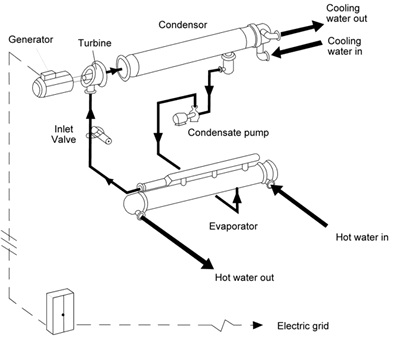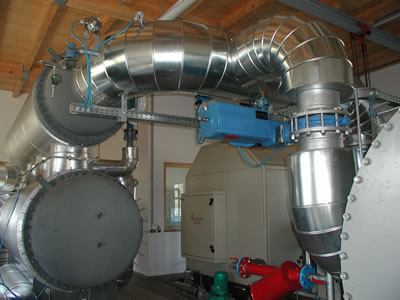The Organic Rankine Cycle (ORC) is a fancy name for a binary system taking heat from a source and transferring it to a working liquid in a closed system to be vaporized and pressurized, typically turn a turbine, then condense back to liquid form before flowing through the heat exchanger again to repeat the cycle. The diagram below breaks out the typical components of an ORC system.

These systems can vary in size from a few hundred kilowatts clear up to hundreds of megawatts. A picture of a 200Kw system is displayed below.

These ORC systems have several key benefits over traditional steam turbines including lower operating temperature (down to 75C,) less wear and tear on turbines (clean single fluid environment,) and no requirement to expose heat source to the environment (no emission power generation is possible using these units in a closed geothermal system for instance.) The major disadvantage to this approach is that energy is lost during the heat transfer process relative to direct use systems.
26 days until OSU plays for the national championship
Ohio State’s 2006 record: 12-0 Next up: Florida 1/8/2007
Tune: Go ‘Head by Ali Gipp featuring Chocolate Tai
Technorati Tags: Energy | Science | Geothermal | Mike Harding Blog
« Heis-Man: Troy Smith
» Now we can all rest easier…
Energy, Innovation
Organic Rankine Cycle
12.13.06 | 5 Comments
5 Comments
« Heis-Man: Troy Smith
» Now we can all rest easier…










I have a 500kw biomass district heating plant fired with virgin woodchip in England
Can anyone point me toward a manufacturer of a system that would allow me to generate electricity and provide CPH on this sort of scale.
Thanks
John, I’d suggest you look at the Pure Play 280 units from United Technologies (UTC.) They generate gross 280kw and net of parasitic load 240kw. Effectively, the unit is an industrial chiller run in reverse. Up to 40 can be ganged into a pod – sounds like you’d need 2 units.
The only gotcha I can think of is access to water for cooling the working fluid during the cycle. If you have access to water though it should work out. The good thing about the water is that it simply runs through a heat exchanger, so there’s no pollution added in the process and can be reused on the other side.
Good luck.
Suspect you have misunderstood gross heat power reqd for purecycle, and , if it is on the market yet , it certainly isn’t at 50 hz, which is mandatory for Europe. Furthermore the refrigerant used is very strictly controlled in thee EEC.
You may care to look at Freepowers web site, pretty hard work at present , but about to be rebuilt, and at least the ORC is built in UK. There is a downrated 120 kW system and a 50/60 kWe system coming on stream at the end of the year. They are very compact, easily forkliftable and about the most efficient available anywhere.
I am searching for a method of “screening for optimal working fluids for ORC-technology”. Can anyone send me some information upon. Thank you
Hi,
I am Esad, working on ORC in Bosnia for my postgraduate study.
Can anyone please provide my with proper explanation on this:
I read from many ORC related articles that ORC working fluids should have a high molecular weight to avoid the need for high turbine rotational speed.
I do not understand it well, how the molecular weight of organic fluid relates to low rotational speeds?
Thanks
Esad